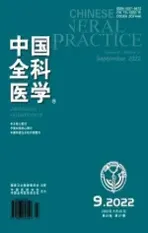澳大利亚JohnMurtagh全科病案研究 (三十一)——突然单侧视力消失
2011-08-15JohnMurtagh
JohnMurtagh(著), 杨 辉(译)
作 (译)者单位:3165澳大利亚维多利亚州, 澳大利亚Monash大学
1 病史
一位65岁的商店店主前来就诊。他就诊的原因是6 h前左眼突然看不见东西。左眼视力消失仅持续了5 min, 然后就完全恢复了。他形容当时 “好像眼前垂下了一张黑幕, 挡住了所有的光线”。在视力消失的过程中, 他没有其他不适症状。
他是我的老病人, 我知道他有高血压和糖尿病。现在他每天吃的药包括降血糖药二甲双胍850 mg和抗高血压药培哚普利10 mg。他还吸烟, 每天抽15支。他不饮酒。
我还知道他的家族史, 他父亲67岁的时候死于脑卒中,母亲69岁的时候死于乳腺癌。
2 针对病案提出的问题及答案
2.1 问题1:根据上面这个简单的病史, 你的初步诊断是什么, 鉴别诊断是什么?
答案:初步诊断是一过性单眼盲, 或称为暂时性单眼失明症、单侧黑朦症。它是暂短性脑缺血发作 (TIA)的临床表现。极有可能的原因, 是一个从左颈动脉分叉脱落的血栓经过了视网膜动脉。这常常是颈动脉狭窄的第一个临床证据。大约有20%的暂短性脑血管发作表现为暂时性黑朦症。
鉴别诊断包括如下情况:(1)视网膜脱离;(2)视网膜出血;(3)视网膜静脉血栓;(4)急性青光眼;(5)颞动脉炎;(6)视神经炎。这些严重的眼科或血管疾病往往不会表现为一过性的失明, 视力消失的病程往往较长, 而且有些疾病造成永久性失明。另外, 还要考虑到偏头疼 (非典型性偏头疼的先兆)和低血糖。
2.2 问题2:在体检的时候, 应该主要关注哪些方面?
答案:主要应检查病人的视力。还应该做神经学检查和心血管检查, 着重发现导致视网膜或脑血管血栓的可能原因。神经学检查包括:(1)视觉分辨能力;(2)视野;(3)检眼镜检查。心血管检查包括:(1)脉搏;(2)血压 (双侧);(3)心脏和颈动脉听诊。
2.3 问题3:你认为最好做哪些一线的检查?
答案:进一步的检查应该主要针对寻找视网膜栓塞的可能原因, 包括:(1)颈动脉多普勒超声波检查;(2)心电图检查发现是否心律失常; (3)对心瓣膜进行超声心动图检查,发现是否存在血栓。如果有可能的话, 可以做脑血管CT或核磁共振检查, 以排除脑梗死、小范围出血或肿块病变。
3 进一步的讨论
请讨论初步的治疗计划。
4 讨论结果
这是一个典型的暂时性单眼失明症的病例。很多暂短性脑缺血发作的病人都有相同的症状。对待这样的病人, 应该当作医疗急诊来处理, 因为病人很有可能继续发展成为脑卒中(脑梗死)。
比较理想的办法, 是马上让病人住进脑血管病房。如果病人对阿司匹林不过敏, 则可以马上给病人300 mg阿司匹林。如果病人对阿司匹林过敏, 则应该使用替代性的抗血小板药物(如氯吡格雷)。抗血小板/抗凝药治疗 (特别是对颈动脉缺血)可以预防30%的暂短性脑缺血发作演变为脑卒中或死亡。
在医院里, 可以根据脑血管病房的检查能力和专业经验,采取动脉内囊切除术或经皮腔内血管成形术 (放支架)。
History
A 65 year old shopkeeper presents because of an episode of loss of vision in his left eye about six hours previously.The visual loss lasted for about 5 minutes only and then recovery was complete.He described the event as though′a curtain came down from above and blocked out the light′.He had no other symptoms at the time of the episode.
You learn thathehas ahistory ofhypertension and Type 2 diabetesmellitus.His current drug therapy is metformin 850mg and perindopril10mg daily.He smokes15 cigarettes a day but does not drink alcohol
Family history:father died of a stroke aged 67 and mother died ofbreast cancer aged 69.Questions 1.Based on thisbriefhistory what is your provisional diagnosis and differential diagnoses?
2.What are the relevant components of the physical exam ination?
3.What would be the appropriate first line investigations?
Answers
1.The provisional diagnosis is transientmonocular blindness known as amaurosis fugax-a transient ischaemic attack(TIA).Themost likely cause is passage ofan embolus through the retinalartery from embolisation of the left carotid artery bifurcation.It is often the first clinical evidence of carotid artery stenosis.About 20% of all TIAs present asamaurosis fugax.
The differential diagnoses include the following although these seriouseye or vascular conditions are not transient and thus have more prolonged(even permanent)lossof vision.Retinaldetachment Retinalhaemorrhage Retinalvein thrombosis Acute glaucoma Temporalarteritis Optic neuritis
Consider alsomigraine(the auraofatypicalm igraine)and hypoglycaem ia
2.The key components of the physicalexamination are the patient′s应该严肃地告诉病人要戒烟。同时要对病人的高血压病和心脏病进行评估。另外还应该做血脂检查。
1 Tiller J(Chair).Therapeutic guidelines:Neurology[ M] .Version 3,Melbourne:Therapeutic Guidelines Ltd, 2007:167-184.
(文后附原文)vision, a neurological examination and a cardiovascular examination focussed on searching for apotential cause of retinalor cerebralembolisation
Neurologicalexamination Visualacuity Visual fields Ophthalmoscopy Cardiovascular Pulse Blood pressure(both arms)Auscultation-heartand carotid arteries
3.The investigation which should focus on finding the potential source of retinal embolisation includes Duplex ultrasound of carotid arteries ECG to check for arrhythm ias Echocardiography to focuson valvesand presence of thrombosis
It is advisable to have a cerebral CT scan or magnetic resonance imaging(if available)to exclude an infarct, small haemorrhage ormassoccupying lesion.
Question
Discuss the initialmanagement.Answer
This is a classic presentation of amaurosis fugax and like all TIAs thereforemust be treated as amedicalemergency as itmay be the fore-runner of amajor stroke(cerebral infarct).Ideally the patient should be adm itted to a strokeunit in amajor hospital.If the patient is not allergic to aspirin, aspirin 300mg should be commenced immediately.If the patient is known to be allergic to aspirin an alternative anti-platelet agent such as clopidogrel should be used.Anti-platelet therapy(especially for carotid ischaemia)gives30% protection from strokeor death after TIA-compared with no treatment.Depending on investigations and the expertise of the stroke unit carotid endarterectomy or percutaneous transluminal angioplasty(stenting)may be undertaken.The patient should be strongly advised to cease smoking and his diabetic and hypertensive status evaluated.Investigations should also include serum lipids.
Reference
Tiller J(Chair).Therapeutic guidelines:Neurology(Version 3).Melbourne:Therapeutic Guidelines Ltd.2007:167-84
